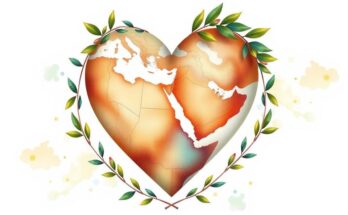Seismic activity around Santorini has surged, with over 7,700 earthquakes detected since January. A significant 5.0 magnitude quake occurred on February 9, raising concerns about potential larger events. Cautious optimism prevails among experts despite local anxieties and preparations for emergencies.
Seismic activity surrounding the Greek island of Santorini has significantly intensified since early February, particularly marked by a 5.0 magnitude earthquake occurring on February 9, 15 kilometers southwest of Arkessini, Amorgos. This tremor was the most powerful since a previous earthquake of 5.2 magnitude on February 5, raising concerns among residents and experts about the potential for a major seismic event in the region.
Vasilis Karastathis, Director of the Geodynamic Institute, expressed a tempered sense of optimism regarding these seismic occurrences. He noted a shift to a more deliberate rhythm in the quakes, stating, “Since the day before yesterday, a better rhythm has started, a slower rhythm in the earthquakes. This has been maintained.” Nonetheless, he reiterated that the risk of a more significant earthquake remains possible.
Local anxiety has surged as residents of Santorini and nearby islands, such as Amorgos, prepare for emergencies, even resorting to keeping emergency bags in their vehicles overnight. The ongoing seismic activity has necessitated evacuations, with thousands of both inhabitants and tourists leaving the island in recent weeks, reflecting the heightened concerns about safety.
Panagiotis Karydis, a Professor specializing in Anti-Seismic Constructions, underscored the vital role of an earthquake’s epicenter in assessing its potential impact. He stated, “An earthquake from the northeastern side of Santorini, at 6 Richter, in my opinion, will create much smaller problems than one at 4.5-5 Richter from the area of the Caldera,” highlighting the importance of location in determining damage risk.
Experts have initiated close monitoring of the seismic situation, installing additional seismographs to deepen the understanding of the ongoing earthquake activity. Furthermore, oceanographic studies have been planned to investigate the underlying causes of continuous tremors experienced in the area since January 26, when a swarm of earthquakes began. Experts have recorded over 7,700 earthquakes in the Santorini-Amorgos region, with around 6,000 detected in the maritime zone.
Seismologist Gerasimos Papadopoulos remarked on the current state of seismic activity, indicating, “We have reached the critical point. We have the first case, if the 5.2 Richter was the main one.” He emphasized the need for ongoing analysis to assess whether the current earthquakes are diminishing or persisting.
The reach of concerns extends beyond Greece; reports regarding Santorini’s seismic activity have prompted fears of a potential tsunami impacting Israel. In response, an emergency meeting of Israel’s National Security Council was convened to gauge potential threats. Deputy officials are assessing the risks in collaboration with government agencies [https://www.blic.rs/vesti/svet/naucnici-predvidjaju-potres-od-6-rihtera-na-santoriniju-panika-medju-stanovnicima/nt4dw94].
Dr. Efraim Laor assessed the likelihood of a tsunami wave reaching Israeli shores, asserting, “In any case, if an earthquake of more than 6.5 degrees occurs on the island, then there will definitely be a tsunami, but it is not at all certain that it will reach Israel.”
The geological intricacies of the area between Santorini and Amorgos are significant, noted for its active faults and tectonic movement. Historical context further compounds the concern, as a devastating 7.7 magnitude earthquake in 1956 caused widespread destruction across Santorini, Crete, and other regions of the Eastern Mediterranean, accompanied by a tsunami nearly 30 meters high.
In summary, Santorini is currently experiencing significant seismic activity, with over 7,700 earthquakes recorded since January. Experts express cautious optimism as they monitor the situation, though residents remain anxious, preparing for potential larger seismic events. The geological complexities and historical precedents underscore the seriousness of the situation, prompting actions not only within Greece but across neighboring regions.
Original Source: www.jpost.com




